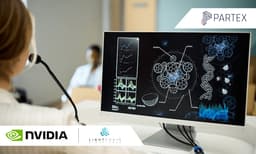

Innoplexus wins Horizon Interactive Gold Award for Curia App
Read More


Innoplexus wins Horizon Interactive Gold Award for Curia App
Read More

Ontosight - Newsletter
July 29th - August 11th, 2024 - Issue 6
Welcome to the 6th edition of Ontosight Newsletter! This issue highlights major advancements in cancer research, including novel therapies and mechanisms of resistance. Explore breakthroughs in neurology, highlighting innovative treatments and insights into neurodegenerative diseases. Dive into recent findings in immunology and cardiovascular health, showcasing new approaches to treatment and disease management. Additionally, catch up on the latest regulatory approvals and industry news.
Featured Articles
1. Cancer Research and Treatments
This study identifies de novo sphingolipid synthesis as crucial for cancer immune evasion but not for cancer cell proliferation in culture or immunodeficient mice. Blocking sphingolipid production enhances the anti-cancer effects of natural killer and CD8+ T cells, partly through interferon-γ signaling. Inhibiting glycosphingolipid synthesis, combined with checkpoint blockade therapy, boosts the anti-tumor immune response Read More.
This study identifies mesenchymal stem cells with inflammatory features (iMSCs), induced by cancer-secreted extracellular vesicles (EVs), as key drivers of therapy resistance in bone cancer. iMSCs mimic inflammatory signatures seen in patient biopsies and hinder anti-metastatic treatments. The research highlights that blocking EV-activated pathways with ladarixin and tocilizumab disrupts metastasis and overcomes iMSC-induced resistance, offering a promising strategy to improve therapy response in bone cancer Read More.
This study explores EphA3-targeted CAR T-cell therapy as a potential treatment for glioblastoma. EphA3, highly expressed in glioblastoma, especially on tumor vasculature and brain cancer stem cells, is targeted using a novel chimeric antigen receptor (CAR). The therapy showed significant efficacy in killing EphA3-positive glioblastoma cells, both in vitro and in xenograft models, and effectively targeted patient-derived glioblastoma neurospheres and organoids. The findings highlight the potential of EphA3 CAR T-cell therapy as a promising approach for treating glioblastoma Read More.
This study examines the role of Carnitine palmitoyl transferase 1a (Cpt1a) in ErbB2-driven breast cancer. Ablating Cpt1a delays tumor growth and metastasis but increases glucose dependency, leading to oxidative stress. Targeting Cpt1a alongside HER2 therapies or using a ketogenic diet enhances antitumor effects and reduces metastasis, highlighting a potential strategy to overcome resistance in HER2+ breast cancer Read More.
2. Neurology & Neurodegenerative Diseases
This study reveals that ketamine's antidepressant effects are primarily due to its action on NMDARs in lateral habenular (LHb) neurons, not in hippocampal neurons, despite widespread NMDAR expression. This regional specificity is linked to local neural activity and NMDAR properties. Inactivating LHb neurons or knocking out NMDARs in this region blocks ketamine's antidepressant effects, suggesting a targeted approach for more precise treatments Read More.
This study explores the neurobiological basis of acupuncture's effectiveness in treating Parkinson's disease (PD). In a PD mouse model, acupuncture activates hypothalamic MCH neurons, which connect to the substantia nigra and hippocampus through distinct neural pathways. Targeting these pathways via chemogenetic manipulation shows that MCH neurons play a crucial role in motor recovery and memory improvements, offering insights into acupuncture's therapeutic effects and potential cellular targets for PD treatment Read More.
This study used quantitative mass spectrometry to analyze over 9,000 proteins in brain tissues from individuals with Lewy body dementia (LBD), revealing distinct protein alterations compared to Alzheimer's disease (AD). The findings highlight differences in synaptic, metabolic, and inflammatory pathways between LBD and AD, with synuclein-associated proteins elevated in LBD and glial-associated signatures varying based on amyloid burden. These results suggest that the LBD brain network proteome could serve as a valuable source of biomarkers for improved diagnosis and treatment Read More.
This study demonstrates that neurons reprogrammed from fibroblasts of individuals with late-onset Alzheimer's disease (LOAD) can effectively model key AD neuropathologies, including amyloid-β (Aβ) deposition and neurodegeneration. The research shows that early treatment with β- or γ-secretase inhibitors can prevent neuronal death, and inhibiting age-associated retrotransposable elements reduces both Aβ deposition and neurodegeneration, highlighting the potential of miRNA-based neuronal reprogramming for studying LOAD Read More.
3. Immunology and Infectious Diseases
This study reveals that the gut microbiota-derived short-chain fatty acid butyrate enhances the clearance of apoptotic cells (efferocytosis) by macrophages. Antibiotic-treated or germ-free mice with depleted gut microbiota show impaired efferocytosis, which butyrate can rescue. The research highlights the role of distal metabolic signals in maintaining tissue homeostasis and suggests that impaired efferocytosis may link antibiotic use to increased inflammatory disease risk Read More.
This study shows that IRF3, a key antiviral protein, suppresses inflammation by interacting with NF-κB and inhibiting its activity. Using Irf3Δ/Δ mice, researchers found that IRF3 deficiency leads to heightened inflammatory responses, increased lung damage, and higher mortality following respiratory virus infections. Specifically, IRF3 in macrophages plays a crucial role in controlling inflammation by inhibiting NF-κB and MAPK signaling pathways Read More.
This study introduces a novel nanovaccine platform for nasal administration designed to enhance mucosal immunity against respiratory viruses. The flexible platform delivers multiepitope nanovaccines, including SARS-CoV-2 peptides, with adjuvants to stimulate both local and systemic immune responses, producing IgA that neutralizes SARS-CoV-2 variants. The lyophilized nanovaccine is stable at room temperature, addressing cold chain limitations and offering a modular solution for future viral threats Read More.
This study identifies mechanisms linking obesity to pancreatic cancer by showing that serum from obese individuals alters inflammatory cytokine signaling and ferroptosis in pancreatic ductal epithelial cells. Enhanced interaction between IL-34 and ferroptosis defense, amplified by oncogenic KRASG12D, promotes pancreatic ductal adenocarcinoma (PDAC) in obese mice through macrophage-mediated immunosuppression. Single-cell RNA sequencing confirms correlations between cytokine signaling, ferroptosis defense, and BMI in PDAC progression, suggesting new therapeutic targets for obesity-associated pancreatic cancer Read More.
4. Cardiovascular and Metabolic Health
This population-based cohort study found that in patients with immune-mediated inflammatory diseases (IMIDs) and type 2 diabetes, initiating glucagon-like peptide-1 receptor agonists (GLP-1-RAs) was associated with lower risks of all-cause mortality and major adverse cardiovascular events (MACE) compared to dipeptidyl peptidase-4 inhibitors (DPP-4is). Specifically, GLP-1-RA use reduced mortality risk by 52% and MACE risk by 34%, with similar benefits observed in adults without IMIDs Read More.
Using data from 90,167 UK Biobank participants, machine learning models predicted cardiovascular disease (CVD) risk based on micronutrient intake. The eXtreme Gradient Boosting (XGBoost) model identified potassium, vitamin E, and vitamin C as key predictors of reduced CVD risk, with an AUC of 0.952. Subgroup analysis highlighted the role of calcium in older adults and those with higher BMI, and vitamin B6 in women, emphasizing the importance of micronutrient intake and demographic factors in CVD risk prediction. Read More.
This study examines the impact of diabetes on hypertrophic cardiomyopathy (HCM) by comparing 45 HCM patients with diabetes (HCM-DM) to isolated HCM controls. Results show that HCM-DM patients have worse left and atrial ventricular performance, including reduced ejection fraction and impaired strain measurements. Diabetes was associated with lower LV ejection fraction, global longitudinal strain, and increased myocardial fibrosis, highlighting the need for targeted management of diabetes in HCM patients to improve outcomes Read More.
5. Innovative Therapeutics and Mind-Body Health interventions
Disulfiram, an FDA-approved drug, inhibits the NLRP3 inflammasome, which is involved in chronic inflammatory diseases. This drug specifically targets NLRP3 by blocking its palmitoylation, a modification necessary for its activation and localization. Disulfiram effectively suppresses inflammasome activation, pyroptosis, and related inflammatory responses in animal models. This finding highlights disulfiram's potential for treating NLRP3-associated inflammatory conditions Read More.
An advanced lipid nanoparticle (LNP) formulation, "LOOP," improves the delivery of mRNA therapies to the lungs. The iLNP-HP08LOOP system, featuring a high helper lipid ratio and optimized buffers, enhances stability and mRNA expression. This formulation successfully delivers mRNA encoding an IL-11 antibody to the lungs, significantly reducing fibrosis and outperforming traditional delivery methods. The "LOOP" platform offers a promising approach for treating respiratory diseases through inhaled mRNA therapeutics Read More.
This study examined the impact of 24 weeks of Tai Chi therapy on cognitive function and immune-inflammatory pathways in schizophrenia patients. Compared to routine treatment, Tai Chi significantly reduced inflammatory cytokines (TNF-α, IL-5) and improved various clinical symptoms. The results suggest that Tai Chi may enhance treatment outcomes for schizophrenia by modulating immune responses and improving cognitive and psychiatric symptoms Read More.
6. Kidney Diseases and Treatments
Chronic kidney disease (CKD) progression is linked with reduced levels of Lactobacillus johnsonii, a beneficial gut bacterium. Supplementing with L. johnsonii improves kidney function by increasing serum levels of indole-3-aldehyde (IAld), which reduces kidney damage via suppression of aryl hydrocarbon receptor (AHR) signaling. This study suggests that enhancing L. johnsonii levels could offer a new approach to treating CKD by modulating microbial metabolism Read More.
Vancomycin, a common antibiotic, is associated with acute kidney injury (AKI). This study evaluated various biomarkers for AKI, finding that serum cystatin C (CysC) and urinary kidney injury molecule 1 (KIM-1) are better predictors of vancomycin-induced AKI than traditional serum creatinine. KIM-1 levels and changes in eGFR using CysC correlate more strongly with vancomycin exposure, suggesting these biomarkers could improve AKI detection Read More.
Acute kidney injury (AKI) involves oxidative stress and mitochondrial dysfunction. Irisin, a muscle-derived protein, can mitigate kidney damage by enhancing mitochondrial function. This study introduces a macrophage membrane-coated nanocarrier for delivering irisin, improving its circulation time and targeting ability. The irisin-encapsulated nanotherapeutics effectively protect against acute ischemia-reperfusion injury by preserving mitochondrial function, providing a novel therapeutic strategy for AKI Read More.
Additional Highlights
Explore more groundbreaking research and regulatory updates in our newsletter:
Stay informed about the latest in medical research and innovation. Join us in two weeks for more insights into the dynamic world of healthcare and life sciences advancements.
Ontosight – Biweekly Newsletter brings you the top and trending articles on medical advancements and life sciences. Subscribe now to stay updated on the latest breakthroughs and innovations in healthcare.
Sign up for Ontosight today to delve deeper into the world of scientific discovery!


